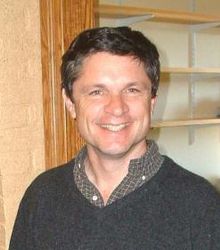Andrew Strominger
Appearance

Andrew Eben Strominger (born July 30, 1955) is an American theoretical physicist, known for his research on quantum gravity and string theory. He has been awarded the Physics Frontiers Breakthrough Prize (2012), the Klein Medal (2014), Dirac Medal (2014), and the Dannie Heineman Prize for Mathematical Physics (2016).
| This scientist article is a stub. You can help out with Wikiquote by expanding it! |
Quotes
[edit]- The conditions for spacetime supersymmetry of the heterotic superstring in backgrounds with arbitrary metric, torsion, Yang-Mills and dilaton expectation values are determined using the sigma model approach. The resulting equations are explicitly solved for the torsion and dilaton fields, and the remaining equations cast in a simple form. Previously unnoticed topological obstructions to solving these equations are found. The equations are shown to agree to leading order in perturbation theory with those derived in a field theory approach, provided one considers a more general ansatz than in previous analyses by allowing for a warp factor for the metric. Exact solutions with non-zero torsion are found, indicating a new class of finite sigma models.
- (1986). "Superstrings with torsion". Nuclear Physics B 274 (2): 253–284. DOI:10.1016/0550-3213(86)90286-5.
- Low-energy effective field theories arising from Calabi-Yau string compactifications are generically inconsistent or ill-defined at the classical level because of conifold singularities in the moduli space. It is shown, given a plausible assumption on the degenaracies of black hole states, that for type II theories this inconsistency can be cured by nonperturbative quantum effects: the singularities are resolved by the appearance of massless Ramond-Ramond black holes.
- (1995). "Massless black holes and conifolds in string theory". Nuclear Physics B 451 (1–2): 96–108. DOI:10.1016/0550-3213(95)00287-3.
- It is shown that many of the p-branes of type II string theory and d = 11 supergravity can have boundaries on other p-branes. The rules for when this can and cannot occur are derived from charge conservation. For example it is found that membranes in d = 11 supergravity and IIA string theory can have boundaries on fivebranes. The boundary dynamics are governed by the self-dual d = 6 string. A collection of N parallel fivebranes contains 12N(N–1) self-dual strings which become tensionless as the fivebranes approach one another.
- (1996). "Open p-branes". Physics Letters B 383 (1): 44–47. DOI:10.1016/0370-2693(96)00712-5.
- Much of theoretical physics over the last century has concerned the reductionist quest to uncover the laws of nature at ever shorter distances. In the last decade it has become increasingly clear, from a variety of investigations, that this long march into the ultraviolet has neglected a surprising wealth of uncharted phenomena in the deep infrared (IR). Far from being a boring place where all is trivial and well-understood, the deep IR in four-dimensional Minkowski space has a rich structure which we are only beginning to understand. Applications range from the IR divergence problem in QED, 𝒩=4 Yang-Mills and color memory in QCD in black hole information and a possible fundamental new perspective on space, time and nature.
- "Preface". Lectures on the Infrared Structure of Gravity and Gauge Theory. 6 March 2018. ISBN 9780691179735.
- We have no idea what science will look in, say, twenty or thirty years. ... Every scientist has to bet. Science is not a science — it's an art and a gamble.
- (January 9, 2023)"Mindscape 222 | Andrew Strominger on Quantum Gravity and the Real World". Sean, Carroll, YouTube. (quote at 1:19:32 of 1:24:27 in video)
- Why would there be math that had no physical manifestation?
- (February 15, 2023)"Andrew Strominger: Black Holes, Quantum Gravity, and Theoretical Physics | Lex Fridman Podcast #359". Lex Fridman, YouTube. (quote from 1:18:41 of 2:19:34)
External links
[edit]![]() Encyclopedic article on Andrew Strominger on Wikipedia
Encyclopedic article on Andrew Strominger on Wikipedia
